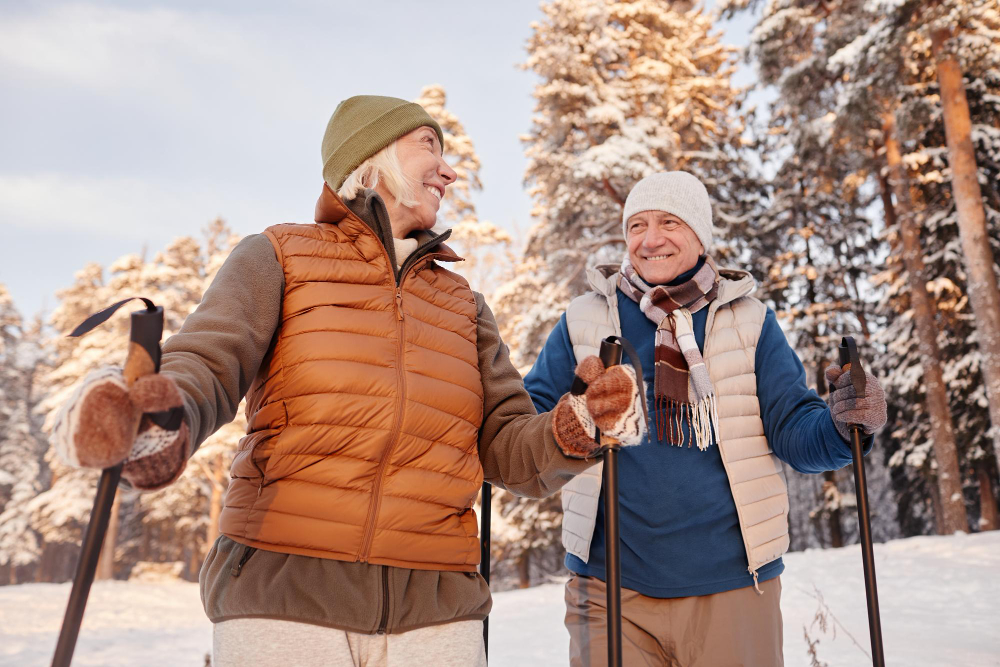Nordic walking - a simple and effective workout for everyone?

Nordic walking is a form of activity involving walking with specially designed poles. It is an easy to learn discipline that engages most of the muscles in the human body to work. As a result, activity can have a positive effect on cardiovascular function or weight reduction, and can increase efficiency and condition.
Marching with poles was invented by the Finns as a form of year-round training for cross-country skiers. Today, Nordic walking is popular all over the world, both among young people and seniors.
Nordic walking - what is it?
Nordic walking is a form of outdoor activity that involves walking with special poles. It is classified as an effort with endurance characteristics and requires good motor coordination.
The sport was invented in the 1920s as a year-round activity for cross-country skiers. However, it was in the 80s of the last century that Nordic walking began to gain popularity. The technique of walking with poles has also been used by Scandinavian and Polish skiers.
Less than 30 years ago, the sport was introduced to the international arena. Thanks to numerous studies, nordic walking has been found to have a positive effect on the body not only at the sports level, but also at the recreational or rehabilitation level. Marching with poles began to be used among people with respiratory diseases, chronic heart failure or among people after accidents and sports injuries.
Nordic walking - who can walk with poles?
Nordic walking appears to be a simple form of activity, but it requires knowledge of technique and accuracy. Since training makes perfect, marching with sticks can be practiced by almost anyone.
It is a discipline popular with both the younger generation and the elderly. Nordic walking is a safe sport for seniors as well - the poles necessary for the activity can provide an additional point of support, helping to maintain balance and reducing the risk of falling.
In addition, marching with poles can relieve the joints, both knee and hip, and thus can also be practiced by people with excessive body weight. Nordic walking is also a discipline suitable for people with diabetes (if the attending physician finds no contraindications).
However, it is extremely important to choose the right equipment, exercise technique and warm-up before starting the walk.
Nordic walking - how to choose poles correctly?
I will practice nordic walking - decided!
However, where to begin the adventure in this sport?
First of all, from choosing the right poles.
So what kind of poles will be needed?
First, those that are designed for this form of activity. This is because trekking poles or sticks encountered along the way will not work. The handle of the nordic walking poles should be smooth and slender. It should also have gloves attached to it that allow a firm grip. This is a much easier solution than the straps used on some poles, which can make it difficult to re-grip the poles after they are released from the hand while walking.
The tip of the pole should be slightly sharpened to improve grip, in turn, there should also be elements at the end of the pole called plates to prevent sinking into the ground.
Second, the poles should be individually tailored to the height and physique of the person doing the activity. Proper nordic walking poles held in the hands and at the same time resting on the ground should make a right angle between the arm and forearm. You should see a similar phenomenon between your forearm and the pole held in your hand.
It is believed that for beginners, the length of the stick should be 68% of the height of the person doing the activity. The appropriate size of the equipment can therefore be calculated using a simple formula. Just multiply your height by 0.68.
For those who are more advanced in Nordic walking, it is recommended that the length of the poles is 72% of the body height, which analogously can be calculated by multiplying height by 0.72.
A convenient solution may also be the selection of poles with telescopic adjustment. Then even several people will be able to take turns using one piece of equipment.
The third important consideration when choosing equipment is the weight of the poles. Nordic walking poles should be as light as possible, and at the same time durable. On the market there are, among others, poles made of fiberglass, aluminum or carbon fiber poles. The choice of material is already a matter of individual needs, taste and preferences.
recommended products
Nordic walking clothing and footwear
Poles selected, so the hardest part of equipment selection is behind you. It's time to pay attention to appropriate footwear and clothing. After all, you won't be performing a pole march in slippers and a homemade tracksuit!
Choosing the right footwear for Nordic walking is, despite appearances, very important. First of all, well-chosen footwear should be comfortable. In addition, shoes with a low upper, which at the same time have a sufficiently thick and contoured sole, can be great for performing activities.
Nordic walking shoes can also be equipped with shock-absorbing foam. They can also be slightly beveled at the heel, which can provide stability to the foot. The right footwear should also feature good ventilation and be made of breathable materials.
Clothing designed for activities should be chosen appropriately for the weather. After all, nordic walking is an outdoor sport.
In the summer, the choice of clothing is simple - just wear a comfortable T-shirt and loose shorts that do not restrict your movements. On sunny days, it's also a good idea to remember to wear proper headgear.
In winter, however, things get a bit more complicated. Then it is worth using the rule of three layers - put on thermoactive underwear, the task of which is to drain excess moisture from the skin surface, which can prevent the body from cooling down. The second layer of clothing should be warm clothes - such as a fleece sweatshirt or tracksuit. The third layer is protection against adverse weather conditions, i.e. a rainproof and windproof jacket.
However, it is important to ensure that the clothing does not restrict movement and allows free movement.
Walking technique with poles - or how to walk properly?
For beginners, nordic walking may seem to be a somewhat difficult activity, due to the need for proper coordination of movements, but with time and frequency of walking with poles, the discipline should become a pure pleasure, without any difficulties.
So how to properly walk with poles? The same as during a normal walk - you should make alternating movements. When we take a step with the left foot, we extend the right hand holding the pole forward and vice versa.
Equally important are proper hand movements. Since nordic walking is designed to activate a large part of the muscles in the body, it is important that the hands are not bent at the elbows. The movement should come from the shoulder, and the whole arm should work. The movement should be decisive, but beware of violent waving of the limbs.
Forward movement should be made until the hand is at the level of the navel. The other limb should be all the way behind the buttocks at this time.
It is also important that the poles driven into the ground are not directed sideways. This is an often-repeated mistake, especially among novice nordic walking enthusiasts.
The best ground for nordic walking will be unpaved paths. So it is much better to do activities in the forest than in a city park. It is also worth remembering to always perform at least a short warm-up before walking with poles. In this way, you will minimize the risk of injury.
Nordic walking and weight loss - how to walk to lose weight?
Marching with poles can have a positive effect on overall fitness, as well as support weight loss processes. This is a sport that can also be performed by overweight or obese people - thanks to the poles, the spine and legs are relieved, thus reducing the risk of injury. During intensive walking, metabolism and fat burning can be accelerated, and in addition, since a significant amount of muscle is involved in Nordic walking, walking with poles can be a good form of activity for people who are concerned about body shaping.
The key to success, i.e. weight reduction, is of course regularity and correct walking technique. It is recognized that as little as 1-3 workouts per week of about 60-90 minutes can contribute to the desired results.
An hour-long workout with sticks performed at a brisk walking pace can contribute to a loss of about 400 kcal (or about 150 kcal more than during traditional walking). Remember, however, that only walking with poles is not enough to lose weight. Equally important is a proper and balanced diet and a healthy lifestyle.
Advantages and benefits of nordic walking
Nordic walking can activate as much as 90% of the muscles in the human body, where, by comparison, only 40-50% of the muscles are set in motion during ordinary walking.
Walking with poles can, as we have already mentioned, help to accelerate the rate of calorie burning and thus reduce weight. However, nordic walking can also have a positive effect on cardiovascular function, fitness and endurance.
Among the indisputable advantages of Nordic walking can also include a beneficial effect on the mood of the person practicing this activity - walking with poles can raise the level of endorphins in the body, and thus can positively affect the mood and attitude of the athlete.
Muscle flexibility can also be improved, which can reduce the risk of injury in everyday life.
Nordic walking is a low-cost sport that stands out for its low level of difficulty. It's an activity that can be done by almost anyone anywhere at any time.
Walking with poles is also a safe discipline that can positively affect the overall health of a person and contribute to reducing stress levels.

